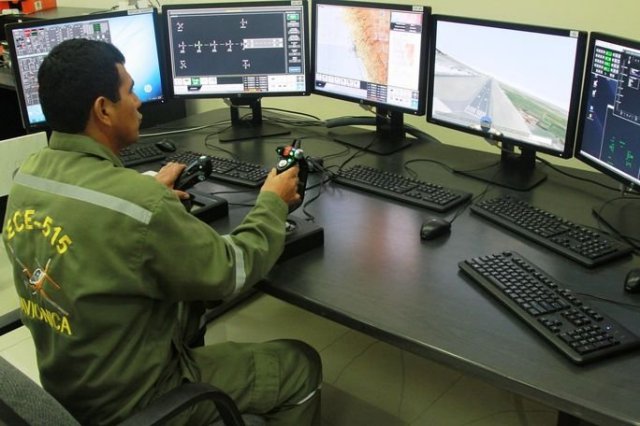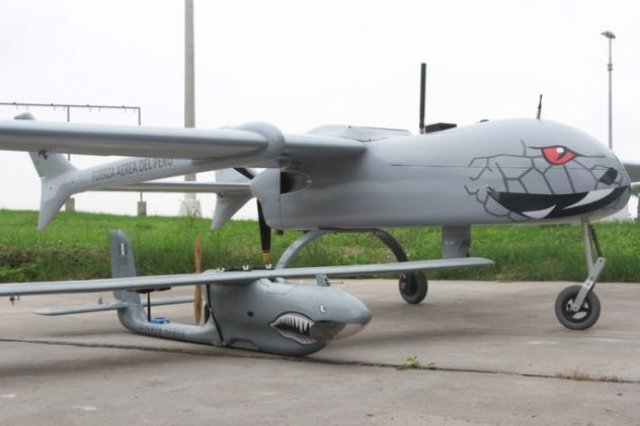The Peruvian Air Force’s (FAP, per its Spanish acronym) Project Research and Investigation Center (CIDEP, per its Spanish acronym) was created in 1993 to develop flight simulators for Cessna A-37 aircraft.
The project was led by officers from the electronic services branch. Following their success, they moved forward with the development of a series of simulators that facilitate training and various exercises for aircraft as well as anti-aircraft systems, rifle firing, and parachuting.
Since then, CIDEP has grown and improved its capacities over its nearly 25 years as a FAP unit, stemming, above all, from new requirements and technologies, and from the development of new personnel capabilities. That is how they came to work on drone development or unmanned aerial vehicles (UAVs) in 2010. Their UAVs have been undergoing continual improvement all the way to the latest Ricuk (“Observer” in Quechua) and Amaru (“red-eyed serpent” in Inca mythology) models, which demonstrate all of the knowledge acquired in the years that CIDEP has been in operation.

In addition to UAVs, the EcoBox System is being developed at CIDEP to facilitate communications between pilots, control towers, and simulators
“We began with basic models from aeromodelling,” Peruvian Air Force Colonel Miguel Palomino Fonseca, the director of CIDEP, told Diálogo. “Little by little, we were able to integrate a set of systems and equipment that enable us to have an unmanned aerial platform to conduct various activities ranging from aerial monitoring to surveillance, security, and intelligence.”
Applied learning
Initial support for the Ricuk and Amaru UAVs was generated by the National Council on Science, Technology, and Technological Innovation, which approved the budget for these projects. That is how FAP came to work with the Peruvian Navy in a joint defense project.
After four years of work between both service branches and having taken the first steps toward developing these UAVs, they conducted a project between Peru and South Korea in which they produced a simulator for basic pilot instruction and training. For UAVs, they developed Scanner, a drone for exclusive use in education and training. “When these technological knowledge transfer experiences happen, our institution requests that the learning be applied. This means that the knowledge is managed,” said Major Juan Talavera, the head of FAP’s press office.
Different scenarios involve action by the Armed Forces, and the natural disasters that routinely happen in Peru demand greater preventive measures. In this regard, UAVs are becoming quite useful tools at a lower operating cost. “We needed an immediate response system that would let us have assistance for natural disasters and do surveillance of the disaster zone in order to have immediate information online. That’s how Ricuk came about,” Col. Palomino said.
Ricuk is already operational. Its structure is reinforced with carbon fiber, and it has long-range sensors for surveillance. It can perform flights of up to one hour at an altitude of 500 meters, and it can roam up to 15 kilometers from its control base.
Meanwhile, Amaru is still in development. “Since we made this aircraft small, we need to do some tests. We need to put in the motor and simulate the load to see whether it’s able to open the parachute. We have a large group of engineers and other professionals who are supervising these tasks,” Col. Palomino explained.
Amaru’s main feature is its autonomy. It flies and lands by itself. It reaches a distance of 50 kilometers [from its base], and it can fly up to 1,000 meters high. It can fly for up to five hours and is equipped with sensors for taking photographs with infrared cameras, which it uses for monitoring, surveillance, and intelligence duties. The aircraft measures 5.17 meters and has parachute equipment that minimizes the potential for damage and the loss of sensors, which are the most expensive part of its structure.
Those who work on UAV development at CIDEP are FAP engineers who were trained at the Officer Academy, which offers four science degrees: Aerospace Administration Sciences, Aerospace Systems Engineering, Aerospace and Aeronautical Engineering, and Aerospace Electronic Engineering. “At CIDEP, other kinds of projects, such as braking parachutes, are also developed. Each one of them costs $26,000 abroad, but CIDEP developed them for $6,000,” Maj. Talavera said.
The principle of continuous improvement
“Our next acquisition of a monitoring system will allow us to transmit the image that the drone sees to any point. The goal is to be able to transmit the images to COEN [the National Emergency Operations Center, per its Spanish acronym], in order to grasp the reality of the disaster in real time,” Col. Palomino disclosed. CIDEP seeks to continue training and backing the 70 people who, in their various capacities, are in charge of developing FAP’s science and technology projects. “FAP is continually upgrading. We are an institution where the use of technology is highly developed,” Maj. Talavera added.
In order to reach these goals, FAP needs a larger budget, as the knowledge and experience required are on par with other technology development centers. For now, CIDEP is already at work on its next UAV, the Pisco (“Bird” in Quechua), whose official debut is planned for the International Aerospace Show to be held in Chile from April 3rd to 8th, 2018.
Photos: Gonzalo Silva Infante
Source: Dialogo

